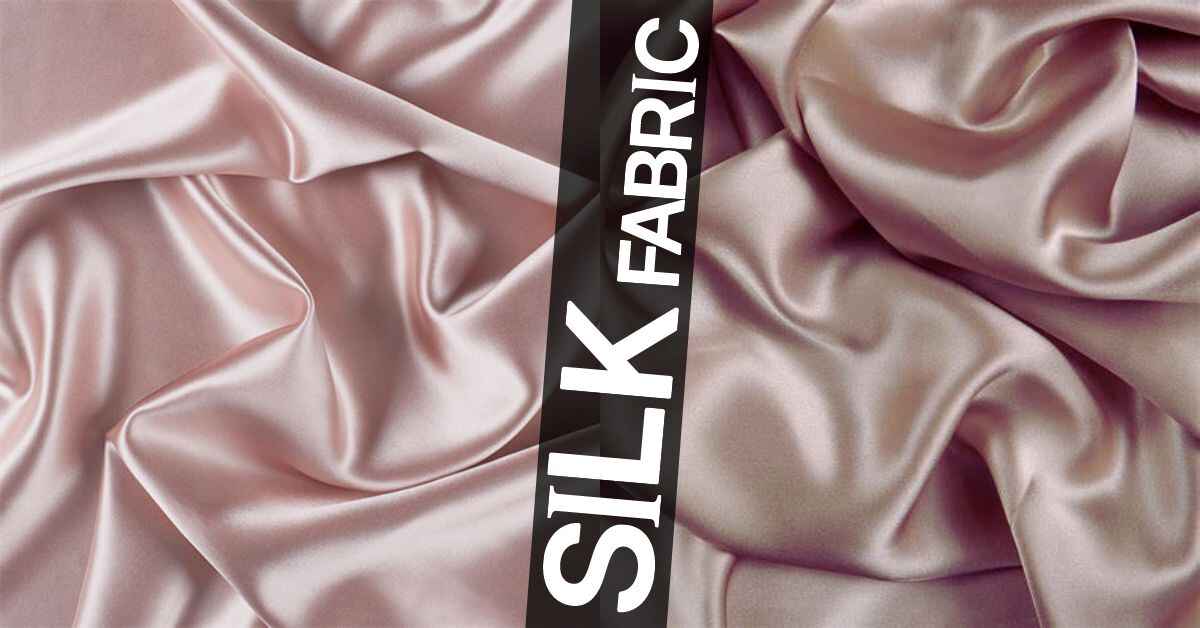Silk is not just a material. It is symbolic of grandeur, age-old style, and craftsmanship of the highest order. For thousands of years, the whole process of silk – from a simple cocoon to the finest of the fabrics – has intrigued human beings. However, what fabric is silk exactly? Why do people find it so appealing? How is it manufactured, and what is done with it? This article focuses on understanding the properties of silk fabric, silk fabric’s making process, and its numerous uses, providing you a close-up of the glamourous fabric.

Introduction to Silk Fabric
Silkworms in the species Bombyx mori originate silk from fibroin, a natural protein. Humans have exploited the silk strands these highly fertile creatures use to make their cocoons for many years. The exceptional quality and beauty of silk have made it one of the most desired fabrics on earth. Nowadays silk is well over two thousand years with peoples` needs and interests in silk expanding relentlessly.
People believe that silk production originated in China around 2700 BC, where the Chinese carefully guarded the craft of silk for many years. The traders termed the Silk Road because of this highly valuable piece of cloth that ran from China to England and other parts of the world. This desire for silk has also continued for generations. They love its smooth surface, shine, and versatility, using it for many things because of its unique properties.

The Properties of Silk Fabric
Grasping the distinguishing features of silk fabric helps explain why people consider it a precious material.
Softness and Sheen:
The one feature that distinguishes silk from all other fabric types is its touch. This happens because it contains protein and hence softer than most outer fabrics. That is the reason silk stands out compared to other fabric materials as it has this almost luminous reflective quality, which plays with light elegantly. For this reason, designers select silk to make clothing for royalty, celebrities, and other luxurious items.
Strength and Durability:
While many people assume silk is weak simply because it looks delicate, that belief is far from the truth. One of silk’s most remarkable features is its tensile strength; by weight, it is stronger than steel. However, it’s important to recognize that silk can also easily deteriorate when exposed to sunlight and moisture. Over time, these factors can cause silk pieces to break down if individuals do not maintain them properly.
Breathability and Comfort:
Silk is also a breathable fabric and can suit any season weather, which is an added advantage. It has been found helpful in skin wicking moisture in high temperatures and in cold removing the moisture from the skin. This is one reason why people have used silk for several hundred years in different materials starting from under-clothes to such as over-clothes, and this is partly due to the fact that it feels good on the skin and therefore it’s quite suitable for people with sensitive skin.
Hypoallergenic Nature:
In comparison to a vast number of synthetic fabrics, silk can be termed as per hypoallergenic. It does not allow the infiltration of humid environments promoting dust-mites, molds as well as fungi which makes it perfect for people with allergies or irritant skin conditions. Silk is perfect for fabrics that are worn on the skin or used for bedding since it acts as a barrier to allergens.
Light in Weight and Flexible:
One of the benefits of silk is that it is so light. Clothes which are made of silk are light in weight and sit well on the contours of the body for an attractive body shape. Its pliability makes it possible for the creators to play around with many fashions and forms.
The Uses of Silk Fabric
Among the fabrics that one can find in the use of different industries and businesses, silk ranks among the most sought after. Its beauty and efficiency make it very useful in numerous areas.
Clothing and Fashion:
In the world of fashion, silk is the king of fabrics. It is used to make evening gowns, ties, scarves, and pretty much all lingerie. Silk is quite popular among
designers as it delivers elegance and improves the body and the design in its turn. The silk suits, blouses, and dresses are the gorgeous pieces expected to be on every woman’s wardrobe to add glam for the events purpose.
Home Textiles:
One of the factors that contribute to the popularity of silk in the making of home décor items such as pillows, curtains, throws, blankets, and bedsheets is its smoothness and soft luxurious touch. Silk sheets and silk pillowcases are recommended for better rest as it is said that it enhances sleep since the surface friction on the skin and on the hair is decreased. There are those who use silk curtains on the windows for a sophisticated luxurious finish to the house, silk cushions can also add beauty and grace to a room.
Clinical applications:
Silk has also been used in the medical field in sutures and surfical meshes. Owing to its compatibility with body tissue, it has been used in surgical threads for centuries. Some researchers also research on the potential uses of silk in regenerative medicine as it is biodegradable and non-toxic.
Creation of Artwork and Embroidery:
Silk threads are prized by artists and embroiderers due to their enacting properties and strength. Even silk embroidery threads are sturdy and enhance a hand-made garment or a textile article with a bright and glistening finish. Garments made with silk wall tapestries and hangings are splendid and many societies value them as important articles.
Other Uses:
It may appear that saying so is unduly minimising the issue, but jokers would like to point out to you that industries use silk biasing in various applications like parachutes, bike tires and military powder bags chiefly for its comfort and ruggedness. It should also be noted that silk may be quite outdated these days, but it still has been extensively used for certain industries because it is so adaptable.
The Making Process of Silk Fabric
Just as complicated and frail as the silk fabric is similar is the making of silk cloth. It requires a combination of labor and time in order to produce silk as it is a very long process spanning from the cocoon to the final fabric.
Sericulture: The Keeping of Silkworms (The Production of Silk)
Silk production begins indeed with the spider silk cultivation, also known as sericulture. Female moths develop egg, laying and thousands of them. They bore fast exclusively on mulberry leaves. Thereafter, when ready, the silkworm encloses itself in a cocoon, which it makes from one filament of silk that can be several miles long.
Reclining the Cocoon
As soon as a cocoon has been formed, it is removed. The cocoon is heated to water in order to save the silk thread. This step also serves to destroy the worm while rendering the sericin that was’T synthesized at the time sticky helps to separate the silk threading without destroying them.
Winding the Silk Yarn
During this process, workers pull the loose silk fibers encasing the pupa. This is done to prevent cutting the thread when a silk reel is being used. To achieve thicker and stronger silk, the people entwine several looms together, which are subsequently manufactured into different grades of silk fiber.
Dyeing the Silk
Dyeing of silk yarn is usually done after its reeling. Silk dyes well due to the protein composition of the silk fiber. This is the reason as to why many silk fabric show off with stunning colors. Depending on the use and the effect desired, both natural and synthetic dyes are involved in this step.
Weaving the Fabric
The last process is that of weaving silk into fabrics. Some areas still use the traditional handlooms, while industrial looms are now popular. Some fabrics that can be made of silk are satin fabric, chiffon fabric, depending on the finish and nature required.
Finishing Touches
In finishing processes applied post-weaving, the weavers carry out washing and bleaching and even dyeing processes of all over to suit the end product expected. After, they check the cloth in order to sell it as raw material or to make it into dresses, textiles and others. Read more Popular Wool Blends.
What is Silk Fabric? Properties, Uses, and Making Process Illustrated
Silk fabric is more than just a splendid cloth piece. This fabric is an outcome of both natural marvel and creative determination. Comparisons of silk as a fabric have not gone out of context in years. Besides its smoothness and luster, silk is one of the strongest materials known to have existed for centuries. The silk fabric is lightweight, has a low allergy index, good for breathability, and other useful characteristics making it highly preferred for both clothing and non-clothing applications.
The processes of making silk textiles are tedious, but this begins with small silk worms, and in the end weaves beautiful women’s self dresses that enhances their beauty. Every phase, from sericulture to finished fabric, plays its part to contribute to the creation of silken fabrics we all treasure. Be it as a dress, a tapestry, or even stitches in a surgical operation, silk is invaluable in its beauty but more than that, in its beautiful yet strong and multipurpose nature.
Silk Fabric: Questions of Sustainability and Ethics
There has been an increasing awareness in the last few decades pertaining to both the ethical and the ecological issues related to silk production. In the case of normal sericulture, the method involves steaming the cocoons with the interfering silkworms hatching within it which is problematic from an animal rights standpoint. In response to this, some producers now offer “Ahimsa silk” or “peace silk,” where they treat the silk by allowing the moth to break out of the cocoon before harvesting it. Although this practice is more socially responsible, it yields short high-temperature fibers which have different silky feel from the other normal silky fibers.
Also, during retreats silk processing there could be an environmental impact because of the usage of excessive water as well as chemicals for dyeing and finishing. Now some of these manufacturers of silk fabrics are also incorporating some of these innovations such as adopting the use of natural dyes and reducing the volume of water used.
Silk fabric Attribute and description
| Attribute | Description |
|---|---|
| Fabric Name | Silk |
| Material Composition | Fibers produced by silkworms |
| Thread Count Range | Up to 600 (though momme weight is more critical) |
| Air Permeability (Breathability) | Very breathable |
| Moisture Control | High |
| Heat Insulation | Low |
| Elasticity | Low |
| Pilling/Bubbling Likelihood | Low |
| Original Production Region | China |
| Leading Production Region Today | China |
| Recommended Washing Temperatures | Cool to warm |
| Primary Uses | Lingerie, nightwear, robes, blouses, suits, sports coats, curtains, medical dressings, parachutes |
Care and Maintenance of Silk Fabric
There is a need to pay attention when it comes to cleaning silk because of its nature. Washing silk with strong detergent or subjecting it to direct sunlight for long hours can lead to the weakening of its fibers and color fading. It’s best to send silk items out for dry cleaning. If hand washing is necessary, use cold water and a detergent with enzymes and surfactants that are safe for delicate fabrics. When washing silk items always remember to let it air dry as heat from a dryer may end up ruining it. It is also essential to store interlining silk properly and avoid hanging it on sharp clothes hangers or to sun exposure.
Conclusion
Among all fibers known to Human beings, the most sophisticated and sumptuous silk fabric can be said to be the most versatile in its use. Everything that silk possesses, such as the softness, the sheen, the strength, the breathable quality, has established silk as a material for garments, home furnishing, and even medical use. Although the preparation of silk is not simple, the end product is a fabric so beautiful and functional that it is worth the time and effort. Gratitude must also be given to the silk’s largely helpful features, however, the ethical matter as well as environmental concerns related to the production of silk must be taken into account. There are greener substitutes for silkworm silk, and a growing recognition of sustainable practices implies that in due course, silk would not only be about luxury, but it will be responsible as well. read more spandex fabric
FAQs
Is silk fabric breathable?
Yes, silk is a naturally breathable fabric. It helps regulate body temperature, keeping you cool in warm climates and warm in cooler weather.
What is the difference between natural and synthetic silk?
Natural silk is made from the fibers of the silkworm’s cocoon, while synthetic silk is often made from materials like polyester. While synthetic silk can mimic some of the aesthetic qualities of real silk, it lacks the same softness, sheen, and hypoallergenic properties.
How do I clean silk fabric?
The best way to care for silk is to dry clean it. However, if you choose to hand wash, use cold water and a mild detergent. Never wring or twist silk, as this can damage the fibers. Always air dry silk and avoid direct sunlight.



